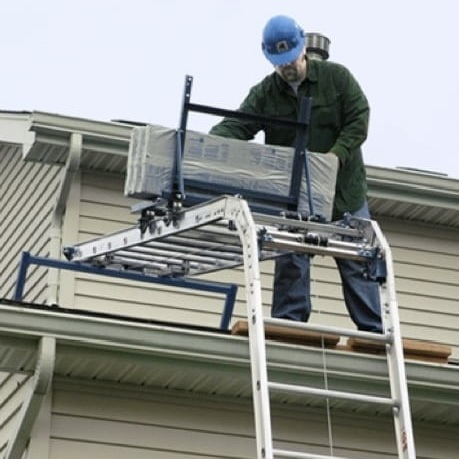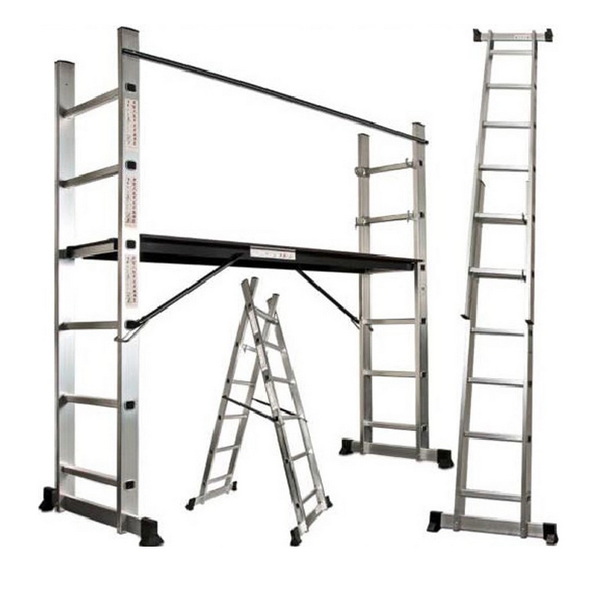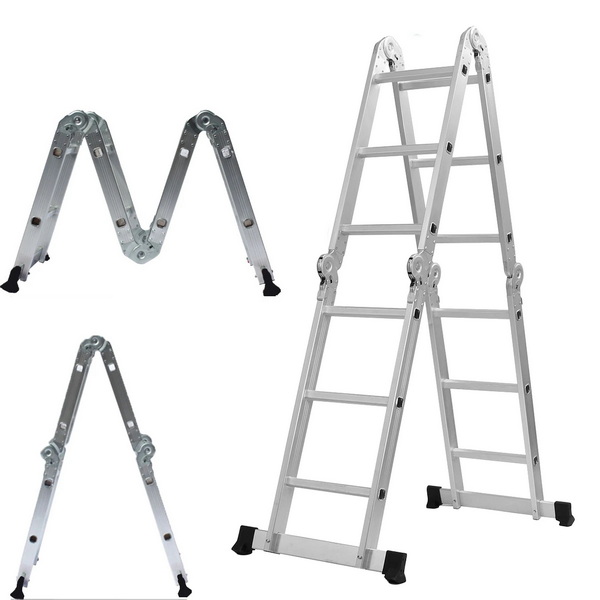Content Menu
● Introduction
● What Is a Ladder That Converts to Scaffolding?
● Key Features and Benefits
>> Versatility
>> Portability
>> Adjustable Height and Width
>> Stability and Safety
>> Cost-Effectiveness
● Step-by-Step: How One Person Sets Up a Ladder That Converts to Scaffolding
>> 1. Prepare the Area
>> 2. Separate the Ladder Sections
>> 3. Attach Trestle or Rail Brackets
>> 4. Position the Trestles
>> 5. Install the Plank
>> 6. Final Safety Check
>> 7. Begin Work
● Safety Tips for Solo Use
● Real-World Scenarios and Applications
>> Painting and Drywall
>> Home Maintenance
>> Construction and Renovation
>> Interior Projects
>> Outdoor Landscaping and Gardening
● Common Challenges and Solutions
>> Weight and Handling
>> Plank Length and Storage
>> Assembly Complexity
>> Platform Stability
>> Working at Height
● Maintenance and Inspection
● Comparing Ladders That Convert to Scaffolding With Traditional Scaffolding and Ladders
>> Traditional Ladders
>> Traditional Scaffolding
>> Ladder That Converts to Scaffolding
● Choosing the Right Ladder That Converts to Scaffolding
● Accessibility and Storage Considerations
● Conclusion
● FAQ
>> 1. Can one person set up and use a ladder that converts to scaffolding?
>> 2. What safety precautions should I take when using a ladder that converts to scaffolding alone?
>> 3. What tools or accessories are needed for conversion?
>> 4. Can these ladders be used outdoors and on uneven ground?
>> 5. Are there weight or height limits for solo use?
The modern construction and DIY landscape increasingly values tools that offer flexibility, efficiency, and safety. Among these, the ladder that converts to scaffolding stands out as a versatile solution for both professionals and homeowners. But how practical is it for a single person to use such a system? This comprehensive guide explores the usability, setup process, safety considerations, and real-world scenarios for using a ladder that converts to scaffolding, with a focus on solo operation.

Introduction
Efficiency and adaptability are crucial on any jobsite or home project. A ladder that converts to scaffolding can function as a step ladder, extension ladder, and a portable scaffold platform. This multi-functionality is especially attractive for solo workers who need to perform tasks like painting, drywall installation, or window cleaning without the help of a crew. But is it truly easy for one person to set up, use, and move such a system? Let's find out.
What Is a Ladder That Converts to Scaffolding?
A ladder that converts to scaffolding is a multi-purpose or combination ladder designed to transform into a stable work platform. Typically, these ladders can be separated into two trestles (A-frame supports), between which a plank or platform is placed, creating a mini-scaffold. Leading brands like Little Giant and Gorilla Ladders offer models with locking hinges, telescoping planks, and dedicated accessories to facilitate this transformation.
Common Configurations:
- Step ladder
- Extension ladder
- Scaffold platform (trestle and plank system)
- Staircase ladder
Key Components:
- Hinged, multi-position ladder sections
- Trestle brackets or rail brackets
- Telescoping or fixed-length planks
- Locking mechanisms for stability
Key Features and Benefits
Versatility
- Functions as multiple tools in one: step ladder, extension ladder, and scaffold.
- Suitable for painting, drywall, electrical work, siding, and more.
Portability
- Most systems are lightweight aluminum and easy for one person to carry and store.
- Foldable and compact for transport.
Adjustable Height and Width
- Telescoping planks and adjustable ladder heights accommodate different job requirements.
Stability and Safety
- Wide base and locking mechanisms provide a stable working platform.
- Some models support up to 500 lbs (two-person rating), but can be safely used by one person.
Cost-Effectiveness
- Replaces the need for separate ladders and scaffold systems, saving space and money.
Step-by-Step: How One Person Sets Up a Ladder That Converts to Scaffolding
Setting up a ladder that converts to scaffolding is designed to be manageable by one person, especially with modern systems. Here's a typical process using a Little Giant or Gorilla Ladders system:
1. Prepare the Area
- Ensure the floor is level, clean, and free of obstructions.
- Check for overhead hazards such as power lines.
2. Separate the Ladder Sections
- Unlock the ladder's hinges and separate it into two A-frame trestles.
- For multi-position ladders, remove the outer sections as shown in the manufacturer's guide.
3. Attach Trestle or Rail Brackets
- Insert the trestle or rail brackets into the ends of each ladder section.
- Lock them securely to prevent movement.
4. Position the Trestles
- Place the two trestles parallel to each other, spaced according to the length of your plank.
5. Install the Plank
- Use a telescoping or fixed plank designed for your ladder system (e.g., Little Giant Telescoping Plank).
- Hook the plank securely onto the rungs of both trestles.
- Ensure locking mechanisms are engaged to prevent slippage.
6. Final Safety Check
- Press down on the plank to confirm it's stable and locked.
- Make sure all ladder feet are firmly on the ground and the setup is level.
- Check for any loose parts or missing components.
7. Begin Work
- Climb onto the platform, maintaining three points of contact.
- Use guardrails or personal fall arrest systems if working above 10 feet.

Safety Tips for Solo Use
Using a ladder that converts to scaffolding alone is generally safe if you follow these essential guidelines:
- Follow Manufacturer Instructions: Always use the setup and safety procedures provided by the ladder's manufacturer.
- Check Load Ratings: Ensure your weight and any tools/materials do not exceed the system's rated capacity (commonly 375–500 lbs).
- Lock Everything: Double-check that all hinges, brackets, and plank locks are fully engaged before stepping onto the platform.
- Use on Level Surfaces: Never set up on uneven or slippery ground; use adjustable feet if available.
- Avoid Overreaching: Move the scaffold as needed rather than stretching beyond the platform's edge.
- Inspect Before Each Use: Look for wear, damage, or missing parts.
- Use Fall Protection: For heights above 10 feet, use guardrails or a personal fall arrest system.
- Don't Use Metal Ladders Near Electricity: If working near electrical lines, opt for a non-conductive ladder.
Real-World Scenarios and Applications
Painting and Drywall
A solo painter can set up a ladder that converts to scaffolding to walk along a wall, eliminating the need to constantly move a ladder. The wide platform allows for easy movement and tool storage.
Home Maintenance
For cleaning gutters, installing light fixtures, or washing windows, the scaffold mode offers a stable, elevated surface that's easy to reposition.
Construction and Renovation
Professionals use these systems for siding, trim installation, and ceiling work, especially in tight or awkward spaces where traditional scaffolding is impractical.
Interior Projects
DIYers benefit from the compact size and easy storage, making it ideal for room renovations or repairs.
Outdoor Landscaping and Gardening
These ladders can be used as scaffold platforms for trimming hedges, painting fences, or working on uneven terrain when paired with adjustable feet.
Common Challenges and Solutions
Weight and Handling
- Challenge: Some systems, while lightweight, may still be cumbersome for smaller individuals.
- Solution: Choose models made from aircraft-grade aluminum and check the product weight before purchase.
Plank Length and Storage
- Challenge: Telescoping planks are easier to store but may be heavier than fixed planks.
- Solution: Opt for adjustable planks that collapse for transport and storage.
Assembly Complexity
- Challenge: First-time setup can be confusing.
- Solution: Watch manufacturer demo videos and read the manual thoroughly. Practice assembly before your project starts.
Platform Stability
- Challenge: If not properly locked, the platform can shift.
- Solution: Always double-check all locking mechanisms and use anti-slip feet or mats on smooth surfaces.
Working at Height
- Challenge: Solo users may be tempted to skip safety steps.
- Solution: Never bypass safety for speed. Use fall protection and follow all setup protocols.
Maintenance and Inspection
To ensure safety and longevity, regularly inspect and maintain your ladder that converts to scaffolding:
- Inspect Before Each Use: Check for cracks, bent parts, or loose fittings.
- Clean Regularly: Remove dirt and debris from hinges, rungs, and planks.
- Lubricate Moving Parts: Use manufacturer-approved lubricants for hinges and locking mechanisms.
- Replace Worn Components: Don't use the system if any part is damaged or missing.
- Store Properly: Keep in a dry, secure area to prevent rust or corrosion.
Comparing Ladders That Convert to Scaffolding With Traditional Scaffolding and Ladders
Traditional Ladders
- Pros: Simple, quick to deploy, lightweight.
- Cons: Limited platform space, requires frequent repositioning, less stable for extended work.
Traditional Scaffolding
- Pros: Large, stable platforms; suitable for multiple users and heavy loads.
- Cons: Bulky, time-consuming to assemble, requires more storage and transport space, often needs more than one person for setup.
Ladder That Converts to Scaffolding
- Pros: Combines the best of both worlds—versatile, portable, and can be set up by one person. Offers a stable work platform for solo tasks.
- Cons: Platform size is smaller than full scaffolding; not suitable for very high or heavy-duty work.
Choosing the Right Ladder That Converts to Scaffolding
When selecting a ladder that converts to scaffolding, consider the following:
- Weight and Portability: Can you easily carry and maneuver the ladder and plank?
- Platform Length and Width: Is the scaffold platform wide enough for your tasks?
- Load Capacity: Does the system support your weight plus tools/materials?
- Ease of Assembly: Are the locking mechanisms and brackets intuitive?
- Material: Aluminum is lightweight and rust-resistant; fiberglass is non-conductive for electrical work.
- Brand Reputation: Choose reputable brands known for safety and durability.
- Accessories: Look for compatible guardrails, adjustable feet, and storage solutions.
Accessibility and Storage Considerations
One of the main advantages of a ladder that converts to scaffolding is its compact storage. Unlike traditional scaffolding, which can take up significant space, these ladders fold down to fit in a closet, garage, or vehicle trunk. This makes them ideal for small businesses, solo contractors, and homeowners with limited storage.
Additionally, the ease of transport means you can take your ladder to various job sites without the need for a large truck or trailer. This accessibility is a game-changer for freelance tradespeople and DIYers alike.
Conclusion
A ladder that converts to scaffolding is a game-changer for solo workers, offering unmatched versatility, portability, and safety. With proper setup, inspection, and adherence to safety guidelines, one person can easily and efficiently use these systems for a wide range of tasks—from painting and maintenance to construction and repairs. The key is to choose a quality ladder system, follow all manufacturer instructions, and never compromise on safety. By doing so, you'll enjoy the full benefits of this innovative tool, saving both time and effort on every project.

FAQ
1. Can one person set up and use a ladder that converts to scaffolding?
Yes, most modern systems are designed for solo setup and use. Components are lightweight and feature intuitive locking mechanisms, making assembly straightforward for one person.
2. What safety precautions should I take when using a ladder that converts to scaffolding alone?
Always ensure the system is on a level surface, all locks are engaged, and the load does not exceed the rated capacity. Use guardrails or personal fall arrest systems for heights above 10 feet, and inspect the ladder before each use.
3. What tools or accessories are needed for conversion?
Most systems require trestle brackets or rail brackets and a compatible plank. These are typically included or available as accessories from the manufacturer.
4. Can these ladders be used outdoors and on uneven ground?
Yes, but always ensure the ladder feet are stable and level. Some models offer adjustable feet for uneven surfaces. Never use on slippery or unstable ground.
5. Are there weight or height limits for solo use?
Yes, always check the manufacturer's weight and height limits. Most ladders that convert to scaffolding support up to 375–500 lbs and are suitable for tasks up to about 10–15 feet high.






















